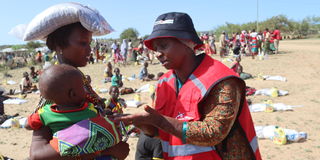Ward’s population explosion worries State and other agencies

Kenya Red Cross Society Secretary-General Dr Asha Mohammed talks to a relief aid beneficiary at Ileret Chief's Office on May 6,2022. She expressed concerns over the worrying exponential population growth in Ileret ward.
The population of the Daasanach community in Ileret ward, Marsabit County, has nearly doubled since 2009, raising concerns among stakeholders because of meagre resources in the region.
According to the 2019 census, the Daasanach numbers stood at 19,337, compared with 12,530 in 2009 recorded by the Kenya Population and Housing Census.
In 2016, the community had about 15,000 members, a Kenya National Bureau of Statistics report showed.
Today, the Daasanach numbers stand at 23,000, according to a report by Malteser International Kenya and the Marsabit County Standardized Monitoring and Assessment in Relief and Transition (SMART) survey of 2022.
Some 12,420 of the 23,000 are acutely malnourished, according to the reports.
Even as Kenya joined other countries in celebrating the 2022 World Population Day, the huge growth in some areas was a cause for worry.
The population explosion among the Daasanach community is a matter of concern for many government and non-state agencies.

Children milk a goat in order to get something to eat at the Bubua area in Ileret on April 1, 2022. Malnutrition rates in the region have been attributed to uncontrolled childbirth by parents
The stakeholders now want the issues to be placed on the front burner as one way of dealing with the alarming malnutrition rates and perpetual food insecurity in Ileret ward.
During his visit to Ileret in May, International Federation of Red Cross and Crescent Society secretary Jagan Chapagain made a passionate appeal to the government and other partners to give special attention to the rapidly growing population.
He attributed the high rates of severe acute malnutrition levels in the region that grip 53.6 percent of the Daasanach population to the population growth caused by unplanned pregnancies and early child marriages, among other factors.
“What we saw has been truly heartbreaking, almost 53.6 percent of the population suffering from acute malnutrition. If immediate action is not taken, this crisis could result in more deaths of children and women,” Mr Chapagain said.
Kenya Red Cross Society official Asha Mohammed also hinted that population control was needed in Ileret, pointing to the role of the human population in driving other species into extinction and precipitating a resource crunch.
Such efforts, she said, should start with reducing child marriages, increasing education levels of women and raising contraception use in the region.
Marsabit County Commissioner Paul Rotich said there was a need for a threshold on the number of births so as to keep the region’s population under control.
This is expressed as the total fertility rate – the average number of children a woman of childbearing age must have.
A sensitisation programme to change women’s mindsets, promotion of contraceptive uptake and discouraging early child marriages should be scaled up among the Daasanach, who are still deeply steeped in tradition.
He held that the remoteness of Ileret ward plays a critical role in the population explosion.
In such remote areas, a child can still work for others to earn a living compared with cities, where children are expensive to raise.
“We are currently in discussions with other partners to see how the debate on Ileret ward’s population needs can be centred around the promotion of rights and education,” Mr Rotich said.
Women, he said, bear the brunt of the crisis as they were mostly the breadwinners of their households.
The average household size in Ileret ward is about 20, compared with the country’s average of 3.9.
Around eight in 10 live births are unintended, unplanned or simply unwanted among the Daasanach.
In Ileret, women with no schooling have an average of 8.1 children, compared with 4.1 children for women with 12 or more years of schooling across Kenya.
The number of women in the 20-24 age group who had married by 12, stood at 80 percent.
The use of contraceptives by married women is unheard of in the area.
The population in the 0-19 age bracket has peaked due to uncontrolled births, forcing children as young as eight to get involved in child labour as a means of survival.
Global fertility rates have fallen below one percent since 2019, according to UN Population Prospects, but the situation is the reverse in Ileret.
A key determinant of the global population rate is the average number of children that women have over a lifetime, which is also known as the fertility rate.
Fertility rates have fallen rapidly across the world in recent decades.
In 1950, the average woman gave birth around 5 times.
However, with time, the fertility rates have more than halved, with the global figure standing at 2.3 births per woman in 2021.
In 1968, Garret Hardin’s paper, “The Tragedy of Commons”, expressed concern about the possible crisis humanity would face due to the exponential rise in population.
The first part of the crisis includes the consumption of resources, including land, food, water, air, minerals, and fossil fuels. The second can be seen as waste products, including pollutants (air and water), toxic materials, and greenhouse gases.
The threshold at which the planet would not be able to sustain a population is being debated.
John Wilmoth, director of the Population Division of the UN Department of Economic and Social Affairs, said a larger population has a higher demand on resources and impact on the environment.
The impact of population on the environment is highly related to consumption and production patterns, as stated in the UN-mandated Sustainable Development Goal 12: ensure sustainable consumption and production patterns.
The English economist Thomas Robert Malthus believed that a balance between population growth and food supply could be established through preventive and positive checks.
The Malthusian Theory of Population is the theory of exponential population and arithmetic food supply growth.





